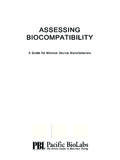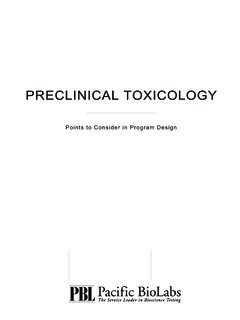Transcription of PRECLINICAL TOXICOLOGY - Pacific Biolabs
1 To view this booklet online, please visit PRECLINICAL TOXICOLOGY GUIDANCE FOR INDUSTRY ICH GUIDANCES TABLE OF CONTENTS Pacific Biolabs Your Partner for PRECLINICAL safety Guidance for Industry M3 Nonclinical safety Studies for the Conduct of Human Clinical Trials for 13 Guidance for Industry S6 PRECLINICAL safety Evaluation of Biotechnology-Derived 27 The Pacific Biolabs Advantage ..28 Contact Information ..29 PRECLINICAL TOXICOLOGY Guidance for Industry Page 1 Pacific Biolabs YOUR PARTNER FOR PRECLINICAL safety TESTING As The Service Leader in Bioscience Testing, Pacific Biolabs (PBL) strives to help our clients deliver safe and effective pharmaceuticals to the patients who need them.
2 Well designed and executed PRECLINICAL studies are critical to the success of any drug development program. They must reliably assess the safety of a new drug entity, laying the groundwork for clinical trials and ultimately, regulatory approval. Pacific Biolabs interacts closely with our clients, providing quality nonclinical testing results to meet regulatory requirements and guide your drug development decisions. As part of our commitment to our clients, we have prepared a pair of publications that will assist you in planning your PRECLINICAL testing program.
3 This publication presents two major ICH guidance documents that directly address safety testing of new pharmaceuticals: Guidance M3 Nonclincal safety Studies for the Conduct of Human Clinical Trials for Pharmaceuticals Guidance S6 PRECLINICAL safety Evaluation of Biotechnology-Derived Pharmaceuticals Both documents are presented in their entirety and can be used as references on questions regarding requirements for safety testing of new chemical entities (NCEs). The FDA website contains these two documents along with a variety of other references on regulatory expectations for the nonclinical development of NCEs.
4 Topics include various aspects of safety ( reproductive, carcinogenicity and genotoxicity), ADME ( bioanalytical, pharmacokinetics and toxicokinetics), and safety pharmacology. PBL s companion publication PRECLINICAL TOXICOLOGY - Points to Consider in Program Design, is available on our website at We hope you find these resources useful, and we wish you the best in your continuing quest to develop safe and effective new medicines. Tom Spalding President Pacific Biolabs Pacific Biolabs The Service Leader in Bioscience Testing Page 2 NOTES PRECLINICAL TOXICOLOGY Guidance M3 Page 3 GUIDANCE FOR INDUSTRY M3 NONCLINICAL safety STUDIES FOR THE CONDUCT OF HUMAN CLINICAL TRIALS FOR PHARMACEUTICALS (July 1997 ICH) Table of Contents I.
5 INTRODUCTION (1).. 4 A. Objectives of the Guidance ( ) .. 4 B. Background ( ) .. 4 C. Scope of the Guidance ( ).. 4 D. General Principles ( ) .. 5 II. safety PHARMACOLOGY (2) .. 6 III. TOXICOKINETIC AND PHARMACOKINETIC STUDIES (3)..6 IV. SINGLE DOSE TOXICITY STUDIES (4) .. 6 V. REPEATED DOSE TOXICITY STUDIES (5) .. 6 A. Phase I and II Studies ( ) .. 7 B. Phase III Studies ( ).. 7 VI. LOCAL TOLERANCE STUDIES (6).
6 8 VII GENOTOXICITY STUDIES (7) .. 8 VIII CARCINOGENICITY STUDIES (8).. 9 IX. REPRODUCTION TOXICITY STUDIES (9) .. 9 A. Men ( ) .. 9 B. Women Not of Childbearing Potential ( ) .. 9 C. Women of Childbearing Potential ( ) .. 9 D. Pregnant Women ( ) .. 10 X. SUPPLEMENTARY STUDIES (10) .. 10 XI. CLINICAL TRIALS IN PEDIATRIC POPULATIONS (11) .. 11 XII. CONTINUING EFFORTS TO IMPROVE HARMONIZATION (12) .. 11 XIII. ENDNOTES (13) .. 12 XIV. REFERENCES (14).
7 13 Pacific Biolabs The Service Leader in Bioscience Testing Page 4 GUIDANCE FOR INDUSTRY M3 NONCLINICAL safety STUDIES FOR THE CONDUCT OF HUMAN CLINICAL TRIALS FOR PHARMACEUTICALS I. INTRODUCTION (1) A. Objectives of the Guidance ( ) The purpose of this document is to recommend international standards for and to promote harmonization of the nonclinical safety studies needed to support human clinical trials of a given scope and duration. Harmonization of the guidance for nonclinical safety studies will help to define the current recommendations and reduce the likelihood that substantial differences will exist between regions.
8 This guidance should facilitate the timely conduct of clinical trials and reduce the unnecessary use of animals and other resources. This should promote safe and ethical development and availability of new pharmaceuticals. B. Background ( ) The recommendations for the extent of nonclinical safety studies to support the various stages of clinical development differ among the regions of Europe, the United States, and Japan. This raises the important question of whether there is scientific justification for these differences and whether it would be possible to develop a mutually acceptable guidance.
9 The present guidance represents the consensus that exists among the ICH regions regarding the scope and duration of nonclinical safety studies to support the conduct of human clinical trials for pharmaceuticals. C. Scope of the Guidance ( ) The nonclinical safety study recommendations for the marketing approval of a pharmaceutical usually include single and repeated dose toxicity studies, reproduction toxicity studies, genotoxicity studies, local tolerance studies, and for drugs that have special cause for concern or are intended for a long duration of use, an assessment of carcinogenic potential.
10 Other nonclinical studies include pharmacology studies for safety assessment ( safety pharmacology) and pharmacokinetic (absorption, distribution, metabolism, and excretion (ADME)) studies. These types of studies and their relation to the conduct of human clinical trials are presented in this guidance. PRECLINICAL TOXICOLOGY Guidance M3 Page 5 This guidance applies to the situations usually encountered during the conventional development of pharmaceuticals and should be viewed as providing general guidance for drug development. Animal safety studies and human clinical trials should be planned and designed to represent an approach that is scientifically and ethically appropriate for the pharmaceutical under development.




